All fractional windings have an inherent front and back offset pitch as it is the current switched during commutation that results in >5000 deg C air detonation (arc) and carbon brush, copper armature that heats up with temperature wear factors and its fractional duty cycle that determines odd or even harmonic content which affects eddy current losses in the steel laminations as eddy current losses rise with frequency.
This is how some harmonic content is suppressed and reduction of copper size, cost and copper losses are done in motor/generators. It is a result of creating fractional pitch windings that are smaller than the mechanical pitch of the magnetic field defined by the key slots.
The other benefit is by changing the duty cycle of the square wave current is the decision to shunt 5th or 7th harmonics by choosing a fractional pitch winding of 4/5th and 6/7th fractional pitch ratio respectively. Some use a compromise of 5/6th pitch to partially attenuate both 5th and 7th harmonics which cause eddy current losses.
Now this fractional winding loop can be staggered such that the leading and trailing edges are different for each application depending on dynamic loads and harmonic issues.
A short answer looks like this.
Here only a back pitch is shown with no front pitch in a fractional winding.

For further research and more details, you may consider here
If you can imagine this loop shifted you get a lead and trail edge offset called Front and Back Pitch.
Since inductive currents lag voltage the phase of the commutators is shifted to reduce the switching arc current at a minimal loss of torque but considerable improvement in switching losses and heat rise.
Other info
This is related but different with brushless motors ( like DC fans) using Hall sensors and PWM phase control, but for different reasons to maximimize speed and torque with the phase of commutation. I have often seen design faults ( even major suppliers like Nydec) where fans with misaligned Hall commutation sensors caused the fan to fail to start either by heat shift or aging or process margin flaws. This results in commutating too close to the zero current or zero torque threshold and it results in dithering back and forth or simply stalled with no torque, unless given a gentle nudge. This happens only because there is a permanent magnet for each resting pole position. It may try to go backwards then forwards or just stalls with no torque. If there is a pitch offset i.e. front pitch then it is gauranteed to rotate in any starting position. I once found 1% of fans failed for this flaw and designed a start stop test so that in 30 seconds a batch of fans could be tested for commutation faults then gave the test jig design to the factory and said we will disqualify them if they do not fix the problem by performing my start-stop test before shipment. They did and then fixed their design/process margin flaw and yields resumed to 100% due to Hall Sensor location offset or if you like, I might call it the "resting forward pitch commutation offset"
For brushed high current motors, the fault might be that brushes or armatures wear out prematurely or the harmonic content makes the steel laminations too hot in high power motor/generators when the wrong fractional winding is choosen for a certain applications.
